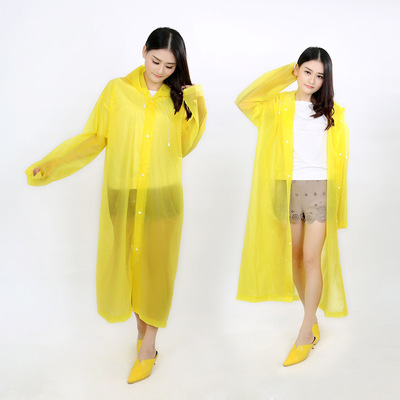1. Fabric
There are three common types of fabrics:
Polyvinyl chloride (PVC): It is the jelly translucent plastic raincoat that is often seen outside. This raincoat is cheap and the disadvantage is that it is easy to break;
Nylon plus polyvinyl chloride: that is, the inner surface of the nylon fabric is coated with a layer of PVC waterproof layer, which is affordable and not easy to break, and is the main material for common raincoats now; , its waterproof and moisture-permeable layer has 1 billion micropores per inch square. These micropores can allow gas molecules to pass through, but cannot allow larger water molecules to pass through, so it can achieve waterproof and breathable effects; the disadvantage is that it is expensive.
2. Workmanship
The workmanship of raincoats is mainly reflected in the needle gauge of the garments. If the equipment for producing raincoats is outdated, the gauges of garments are too large, the needle seam height is inconsistent, and the sealing is not up to standard, it will easily lead to water seepage.
3. Style
When buying a raincoat, you should first consider the rainproof effect and wearing comfort of the raincoat, and then pay attention to beauty and elegance.
Common raincoat styles are as follows: Windbreaker raincoat: Windbreaker raincoat, also commonly known as Peter Pan, cape raincoat, is a common raincoat.
The advantage is that it is easy to use and fast to wear. The disadvantage is that the rainproof function of the legs is slightly insufficient. If the rain or wind is too strong, the legs will often be wet by the rain; Raincoat and rain pants.
The advantage is that the rainproof function for the legs is better than the windbreaker raincoat, but the disadvantage is that it is more troublesome to wear.
4. Breathability
If the air permeability of the raincoat is poor, it will cause the raincoat to seal and cover the human body, resulting in the inability of the hot air from the body to be exhausted, the cold outside and the heat inside, forming water accumulation and wetting the clothes worn on the body. Raincoats should also be maintained to prolong their service life. After using the raincoat, it is best to wipe it with a dry cloth and dry it naturally in a cool place. Do not expose it to the sun. Do not rub when washing the raincoat, as this will cause the PVC and nylon cloth to detach, allowing air to infiltrate and foam. When there is a slight wrinkle on your raincoat, hang it on a hanger and let it straighten out naturally. If the wrinkles are tight, you can soak the raincoat in hot water at about 70°C for 2 minutes, take it out and put it on a flat plate to flatten it, and then wipe off the water marks to restore it to flatness. Be careful not to pull it hard.

















